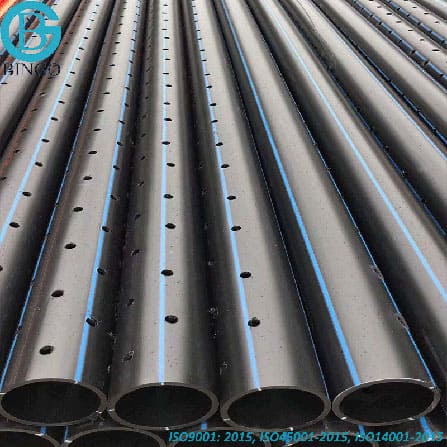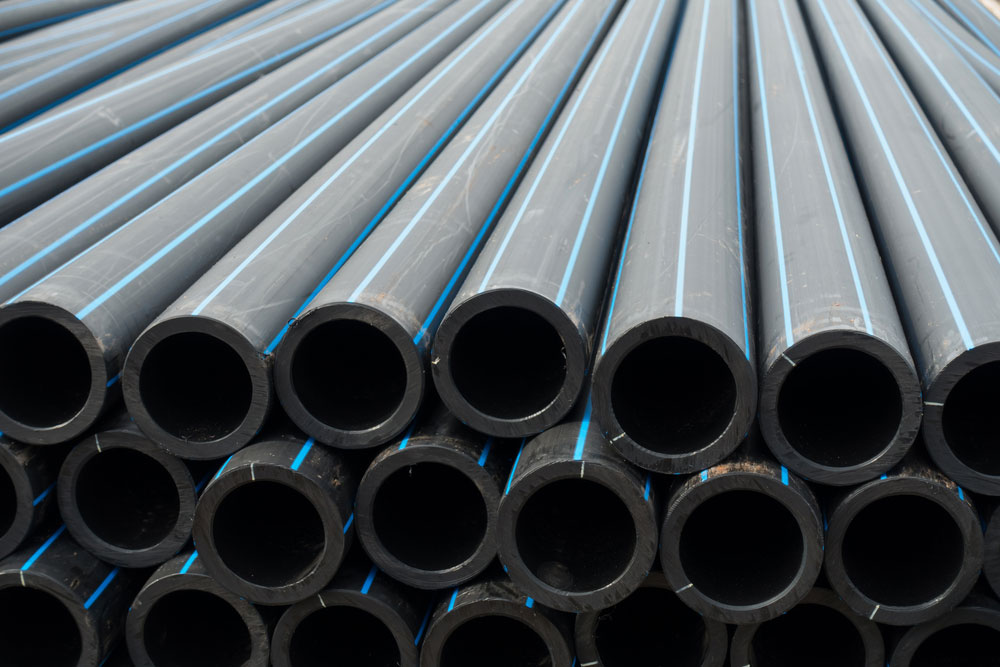American Plastics HDPE Pipe for Oilfield: Built for Harsh Conditions
Wiki Article
Explore the Manufacturing Refine Behind High-Quality HDPE Pipeline and Its Applications
The manufacturing process of high-quality HDPE pipelines is elaborate and methodical. It begins with the choice of basic materials that boost performance. Following this, ethylene undertakes polymerization to form material, which is then formed with extrusion. Quality assurance is critical, guaranteeing that the end product meets rigorous criteria. The trip of HDPE pipelines doesn't end with production. Their applications across different industries reveal a wider value worth examining.Understanding HDPE: Residences and Advantages

High-density polyethylene (HDPE) is a versatile polycarbonate recognized for its durability and resistance to different ecological factors. This material displays superb tensile stamina, making it suitable for demanding applications. Its low-density structure adds to a lightweight item, assisting in ease of handling and installment. HDPE additionally showcases exceptional resistance to chemicals, which lessens degradation when exposed to harsh compounds.
The material's reduced wetness absorption further improves its durability, making it suitable for use in pipelines and storage tanks. Furthermore, HDPE is resistant to ultraviolet (UV) radiation, making sure that products keep their stability also when exposed to sunshine. Its adaptability enables for the development of complex forms without jeopardizing toughness. The eco-friendly nature of HDPE, usually originated from recycled products, includes in its charm, advertising sustainable practices in manufacturing. On the whole, these properties and advantages make HDPE a favored selection for different commercial and consumer applications.
Raw Material Choice for HDPE Manufacturing
The option of resources for HDPE production is crucial to verify the end product satisfies the wanted specs and top quality criteria. High-density polyethylene (HDPE) is mostly generated from polymerized ethylene, originated from nonrenewable fuel sources such as gas or crude oil. The top quality of these feedstocks significantly influences the mechanical and thermal homes of the final HDPE.Additives likewise play a significant function in boosting HDPE's efficiency, consisting of anti-oxidants, UV stabilizers, and colorants, which boost longevity and resistance to ecological aspects. The selection procedure have to think about not just the chemical composition of the raw products however additionally their handling features to guarantee reliable production.
Moreover, the sourcing of resources need to focus on sustainability and conformity with environmental regulations, as responsible techniques are imperative in today's market. Ultimately, mindful raw material selection lays the foundation for creating top notch HDPE pipelines appropriate for diverse applications.
The Extrusion Process: Forming HDPE Pipe
The extrusion process plays an essential function fit HDPE pipelines, beginning with meticulous product prep work methods that guarantee perfect circulation and consistency. Equally essential is the design of the die, which straight influences the last dimensions and surface area quality of the pipeline. Together, these factors add considerably to the efficiency and high quality of HDPE pipe production.Material Prep Work Methods
Effective manufacturing of HDPE pipelines starts with meticulous material prep work methods, particularly the extrusion process. During this phase, high-density polyethylene resin is initial dried to get rid of wetness, guaranteeing suitable flow features. The resin is then fed right into the extruder, where it undergoes home heating and melting, changing right into a viscous state. This heating procedure is very carefully regulated to maintain the product's stability and performance. The molten HDPE is forced via a die, forming it into a continuous pipe form. Proper temperature level management during extrusion is important, as it directly influences the material's properties and the final item top quality. When formed, the HDPE pipeline is cooled and cut to defined sizes, all set for succeeding processing and applications.Die Style Value
Accuracy in die layout plays an important duty in the extrusion procedure of HDPE pipelines. The die works as the final shaping device, straight affecting the pipe's measurements, wall density, and surface area finish. A well-designed die assurances uniform material flow, reducing issues such as irregularities and weak points. The geometry of the die have to be enhanced to accommodate the specific buildings of HDPE, including its viscosity and thermal behavior during extrusion. In addition, the cooling price of the material as it passes via the die can noticeably impact the pipeline's architectural stability. Spending in innovative die innovation is important for producers intending to produce top quality HDPE pipelines that meet sector criteria and customer assumptions.Quality Assurance Procedures in HDPE Production
Although different elements affect the high quality of HDPE pipe production, reliable quality assurance steps are essential to guarantee uniformity and dependability in the last product. Trick high quality control methods include rigorous material assessment, verifying that the raw polyethylene fulfills recognized criteria for pureness and density. During the extrusion process, criteria such as temperature, pressure, and cooling time are closely checked to maintain dimensional accuracy and architectural stabilityIn enhancement, post-production testing is crucial; makers frequently carry out hydrostatic tests to examine the pipeline's stamina and resistance to stress. Visual evaluations for surface defects even more improve quality control. Accreditation from relevant requirements organizations, like ASTM or ISO, offers an extra layer of reputation. By carrying out these thorough top quality control measures, suppliers can reduce problems, enhance performance, and make certain that the HDPE pipes satisfy the certain requirements of different applications, eventually leading to customer contentment here and count on the item.
Applications of HDPE Pipeline Across Industries
HDPE pipes are used throughout numerous fields due to their toughness and versatility. In water distribution systems, they guarantee reliable shipment, while in wastewater management, they offer dependable remedies for waste transport. Furthermore, agricultural irrigation networks take advantage of HDPE's resistance to corrosion and adaptability, making it an excellent choice for contemporary farming techniques.
Water Circulation Solutions
A significant variety of sectors depend on high-density polyethylene (HDPE) pipelines for effective water circulation systems. Known for their resilience and resistance to deterioration, HDPE pipes are commonly made use of in metropolitan supply of water networks, farming watering, and commercial applications. Their light-weight nature assists in easy handling and setup, decreasing labor prices and time. Additionally, HDPE pipes can fit different stress levels, making them suitable for both reduced and high-pressure systems. Texas hdpe pipe manufacturer. The flexibility of the material enables smooth assimilation into existing framework, reducing the requirement for comprehensive excavation. HDPE's resistance to chemical seeping assurances that the water delivered stays risk-free and tidy, making it an ideal option for maintaining the top quality of safe and clean water throughout numerous industries.Wastewater Monitoring Solutions
Effective water circulation systems additionally lead the means for ingenious wastewater monitoring solutions, where high-density polyethylene (HDPE) pipelines play a substantial role. Renowned for their toughness and resistance to corrosion, HDPE pipelines are perfect for transferring wastewater in various setups. Their flexibility permits for simple installment in complex environments, decreasing the need for substantial excavation. In addition, HDPE's smooth interior surface lowers rubbing, boosting flow prices and effectiveness. These pipelines are additionally resistant to chemical leaching, making sure that contaminants do not endanger the surrounding setting. Industries, districts, and therapy facilities progressively count on HDPE pipes for their reliability and long life, making them a preferred selection for modern wastewater monitoring systems. This versatility underscores the vital significance of HDPE pipes across countless applications.Agricultural Irrigation Networks
Agricultural irrigation networks profit greatly from using high-density polyethylene (HDPE) pipes, which supply efficient and reliable water delivery to crops. HDPE pipelines are lightweight, making them easy to transfer and set up, while their versatility enables different setups in diverse surfaces. These pipes demonstrate excellent resistance to corrosion, chemicals, and UV radiation, guaranteeing sturdiness in harsh farming environments. Additionally, their smooth interior surface decreases friction loss, optimizing water circulation and minimizing power expenses related to pumping. The longevity of HDPE pipes, typically exceeding 50 years, adds to decrease maintenance and replacement costs. As a result, farmers progressively depend on HDPE pipelines to boost watering performance and advertise lasting farming practices, eventually bring about improved plant yields and source conservation.Future Trends in HDPE Pipeline Technology
As the demand for sustainable and effective facilities expands, developments in HDPE pipeline innovation are poised to transform numerous sectors. Emerging fads include the assimilation of smart technologies, such as sensors and IoT capabilities, which assist in real-time surveillance of pipeline conditions, minimizing upkeep prices and avoiding leaks. Additionally, the growth of innovative production techniques, such as 3D printing, is allowing the production of complicated, tailored pipe layouts that accommodate particular job needs.The focus on recycling and circular economic climate practices is driving the development of HDPE pipelines made from recycled products, improving sustainability. Improved jointing approaches, such as electro-fusion and mechanical fittings, are likewise improving setup efficiency and dependability. The growing focus on ecological laws is pushing makers to adopt greener production procedures, making certain that HDPE pipelines not only meet market criteria but likewise promote an even more sustainable future for facilities development.
Frequently Asked Questions
Just How Does HDPE Contrast to Other Plastic Materials?
HDPE outshines many various other plastic materials regarding resilience, chemical resistance, and adaptability. Its reduced density and high tensile strength make it excellent for various applications, usually exceeding choices in both efficiency and longevity.What Are the Environmental Influences of HDPE Manufacturing?
The environmental influences of HDPE manufacturing include greenhouse gas emissions, energy usage, and potential air pollution from producing procedures. In addition, improper disposal can cause dirt and water contamination, raising problems regarding long-lasting environmental impacts.Can HDPE Pipes Be Recycled?
Yes, HDPE pipelines can be reused. Lots of centers approve made use of HDPE for processing, changing it into brand-new products. This recycling adds to sustainability efforts, minimizing plastic waste while conserving sources and power in the manufacturing cycle.What Is the Life Expectancy of HDPE Pipes?

How Do Temperature Level Variants Affect HDPE Pipe Performance?
Temperature variants considerably influence HDPE pipeline performance, influencing adaptability and stamina. Heats can bring about softening, while reduced temperature levels might trigger brittleness, inevitably affecting the pipeline's longevity and viability for numerous applications in varied environments.Report this wiki page